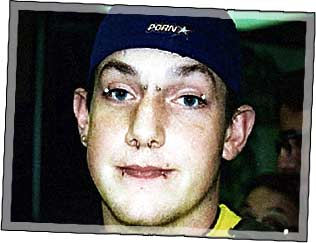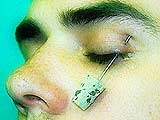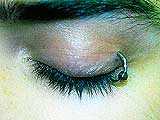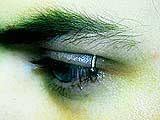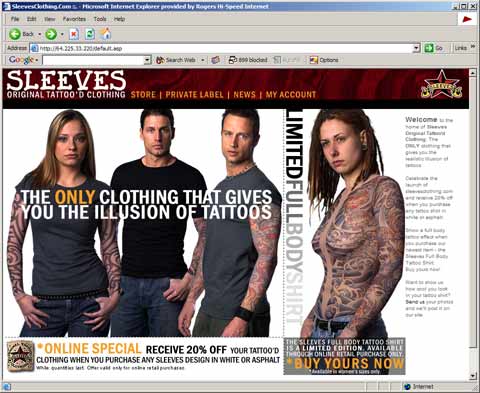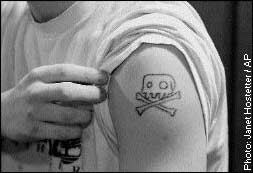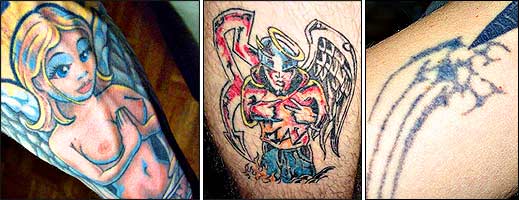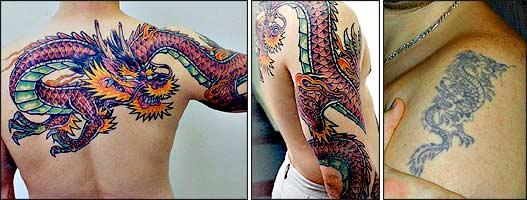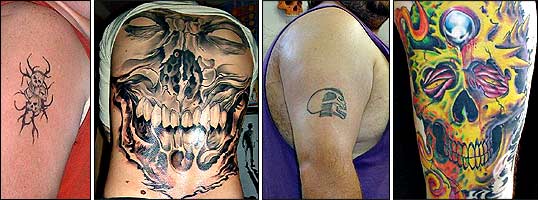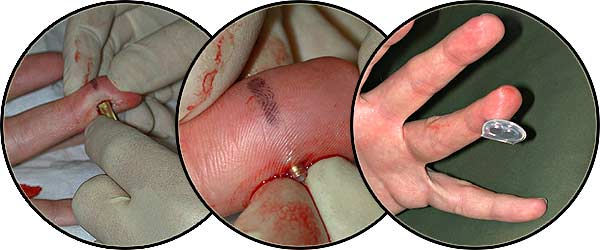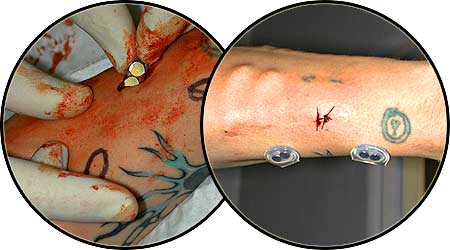 JewelEye (Sung to the tune of Goldfinger) |
“If you are not in fashion, you are nobody.”
– Lord Chesterfield
|
They call Amsterdam the “Ultimate City of Freedom”, or so the t-shirt I brought back for Shannon claims. The border crossing into the country didn’t involve being searched or questioned, and nothing more than pausing to get a Schippol Airport stamp in my passport held me from those freedoms — prostitutes, gambling, drugs, and euthanasia I suppose… but Jen Savage (my traveling companion and soon-to-be nurse) and I had come looking for another kind of freedom: medical freedom.
Most, if not all, of you have heard of the “JewelEye” implant that’s been upsetting conservative doctors lately — it is after all quite literally an implant under the surface of the eye. I decided to come see what it was all about… and to have it done on myself. As of Wednesday May 26, 2004, I am now the first person outside of The Netherlands to have it done.
After a short 30-minute train ride from Amsterdam to Utrecht, we stopped briefly at our hotel and then took a cab into the suburb of Driebergen where we arrived at the notorious Retina Total Eye Care. Far in fact from “notorious”, the clinic is located on a quiet shopping street open only to pedestrians and bike traffic, and looks every bit the designer clinic — walls covered with with Dolce & Gabbana, BVLGARI, Calvin Klein, and GUESS. The clinic’s center is a beautiful koi pond with bamboo growing up to the second story, and as we waited we were served apple juice and espresso.

The Retina Total Eye Care clinic, Driebergen
When they were ready for me I went upstairs where they had the pre-op rooms and their full surgical suite. First I was given a complete eye exam to make sure there were no defects on my eye, and during this exam they determined the optimal positioning of the implant jewelry. The entire white of the eye is suitable for placement (so there was no “mapping of blood vessels” like in procedures such as dermal punching an ear), so the position is a combination of what I wanted and what they recommend — the goal was to have it subtle most of the time, but appear during conversation. Although one might assume it’s a hardcore mod, it’s not supposed to be “in your face”, even though it obviously is. Because we tend to look up when we’re talking, we decided to place the implant — a small platinum star — in the lower left quadrant of my left eye.
I was given a drop of anesthetic in both eyes — the eye not undergoing the procedure needed to be relaxed as well since our eyes move in unison. Two more anesthetic drops were put into my left eye, and an additional antibiotic drop was also given with the anesthetics. The drops stung a bit until they finally took effect. After that I couldn’t feel anything and my eyesight in my left eye became blurry. My hair was put into a hairnet and I changed into a surgical gown, complete with little plastic foot covers.
A sliding door opened and I was brought into an operating room. It was at this point that I really started to feel in good hands and at ease. Everything was top-of-the-line and matched the TV image of the perfect clinic. Everything was clean, white, and new. I got onto the operating table and my head was locked into place. I got another anesthetic drop, and my face around my eye was swabbed down with iodine — getting lots into the eye itself as well.
The table then rotated underneath some very bright lights and what I assume was some kind of microscope. A sterile drape was placed over my face except for a hole for my left eye. My eyelids and lashes were taped back and a claw was put under my eyelids to keep me from blinking (or “winkeling” as the doctors and nurses put it). If you’ve seen A Clockwork Orange you know what I’m talking about!
For most of the surgery I had my eye looking all the way to the right. I was convinced I wasn’t doing what they asked and was having a hard time keeping my eye in place, but they said I never moved once. I guess because my eye was moving due to the pressure that they were exerting on it, I felt that it was me moving it — but there was never any pain and hardly any pressure.
The procedure itself involved injecting a liquid to elevate and separate the layers of the eyeball, which helps the surgeon with the placement of the implant under the conjunctiva (in old age, many people build up calcium deposits in this area, so our eye is actually designed to handle material stuck there). A small flap is cut, and the implant is inserted. After it was in place, they began suctioning out the liquid that was used to elevate the layers. After a few weeks, the liquid will dissipate and the implant will become even more visible.
After removing as much of the elevation liquid (and the iodine) as possible, they removed the tape and sterile cover from my face. The tape being pulled off was actually the only pain that I felt for the entire procedure (I was worried about it pulling out my lashes, but it didn’t)! I can’t stand pulling tape off of myself after a tattoo either. It took about three minutes before I was able to sit up. I felt disorientated — staring into blinding lights while holding your eyes in an awkward position can take more of a toll on your entire body than you’d think. But still, the entire procedure from the start of the examination to getting off the table probably took less than half an hour.
I was taken back to the pre-op room where my face was cleansed of residual iodine and the surgeon gave me another exam to make sure that the implant was positioned properly. I felt very off balance because my left eye was so blurry — the fluid in my eye caused the distortion. In hindsight I’d have liked an eye patch and my eye felt much better when I kept it closed.


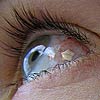
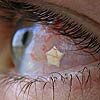
These pictures were taken the evening of the day of the procedure.
The surgeons were adamant that I call them if I was unhappy with the placement or if anything seemed wrong. I went back to my hotel to sleep, but woke up after two hours thanks to jet lag. I slept only off and on, even though I desperately needed a good night of sleep. By morning my eye had started to get quite red. It basically looked like I had pink eye, but with a lot less crusties and drainage. After the eyelid piercing article I was expecting pus, and to have to keep cleaning my eye but there was nothing more to do than my antibiotic drops three times a day. To be honest, I attribute the redness as much to lack of sleep as the implant — as soon as I got a night of sleep the redness was gone.
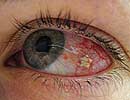
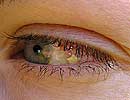
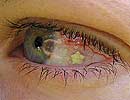
Left: the morning after, Right two pictures: the evening of the day after.
The redness above the implant is bruising from the incision and will go away.
So the morning after having the implant, my eye felt sore, but not uncomfortably so. Looking to the right for too long (posing for pictures!) made the soreness more intense but that would be expected — it felt similar to having an eyelash stuck in my eye. At my initial follow up exam Thursday morning the doctors said everything looked fine, although I did feel my eyes were dry. I asked if I could put saline drops in, and the doctor gave me an ointment for dryness instead and we made one final appointment at their second clinic in Rotterdam for the morning of our flight home.
The remainder of the week was to be spent doing some whirlwind traveling (“ah, an American vacation” a few people remarked; “next time you need to stay a little longer”). First to Liege, Belgium where we met with Marisa (who you know from her legal articles here) and Dan DiMattia of Calypso Tattoo (also no stranger to BME readers). My only problem with Belgium is the sidewalks — they are only about two feet wide! It’s hard to walk in a group, let alone side by side. Conversations have to wait.
I haven’t written much about the aftercare of the JewelEye because it really was a non-issue. Other than the very slight inconvenience of having to complete my course of antibiotic eye drops over the first week, there was barely any discomfort. A scratched eye hurts worse than this did.


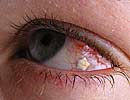
Left two pictures: two days after, Right: four days after.
After Liege, we traveled on to Antwerp, and then up to Venlo on the high-speed train (a big let-down on which we were served some sort of vomit-based dish) where we met with Kor and his Truth Seekers Syndicate for their ritual event which had drawn people from as far as Norway (Håvve Fjell, who you know from Ten Years of Pain) and Brazil. But it was all over so quickly — next time I will try and take the advice to stay longer.
You can also download the video:
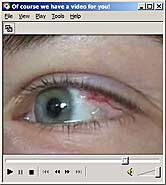 Video (WMV): Hi-Res | Low-Res (High resolution clip is 2 MB, low resolution clip is 0.5 MB. Both are Windows WMV video files). |
But, the trip was over and all that was left was my final appointment with Dr. Melles. He seemed very concerned that the star was a little lower down on my eye than he’d wanted, and asked me to let him know if I ever became unsatisfied and wanted it shifted slightly. He even gave me a note to take to an ophthalmologist locally. But, other than his concern about the aesthetics of the placement, there were no problems and everything seemed normal and healthy.
I want to say that Dr. Gerrit Melles (who developed this procedure as well as being the one who performed it on me) has a really wonderful bedside manner. He treated me kindly and with respect throughout our entire interaction — sadly, not the response a young, heavily tattooed woman is used to getting in this world. He took the time to explain everything in detail before, and as it was happening, which helped keep me calm. I felt like he was talking to me and not “at me”. He went out of his way to make sure I knew to contact him personally if I had any concerns.
As of today I’ve had a platinum star under the surface of my left eye for six days. Healing has been uneventful, and at 750 Euros (about $900 US), even with the price of the airfare and accommodations it cost no more than a large tattoo would. I don’t really know why I wanted it — something about it just struck me. Why do I like a certain hair style, or why do I like a certain song? I thought it was pretty. Whether it comes to mean more or less to me in the future, time will tell, but, I think Dr. Melles put it well when he explained that in all of human history, people have decorated themselves with jewelry. Of all our organs, one can argue that the eye is the most important in social interaction — now that we can do it safely, is eyeball jewelry really that strange?

Rachel Larratt
BMEzine.com
| Rachel Larratt is the copublisher of BMEzine.com, the largest and oldest full-spectrum body modification publication on the planet. Her background is as diverse as one would expect of BME’s coowner, and includes everything from body piercing to developing technology for high-bandwidth media distribution.. |
Copyright © 2004 BMEzine.com Requests to republish complete, edited or shortened versions must be confirmed in writing. For bibliographical purposes this article was first published June 1st, 2004 by BMEZINE.COM in Toronto, Ontario, Canada.

